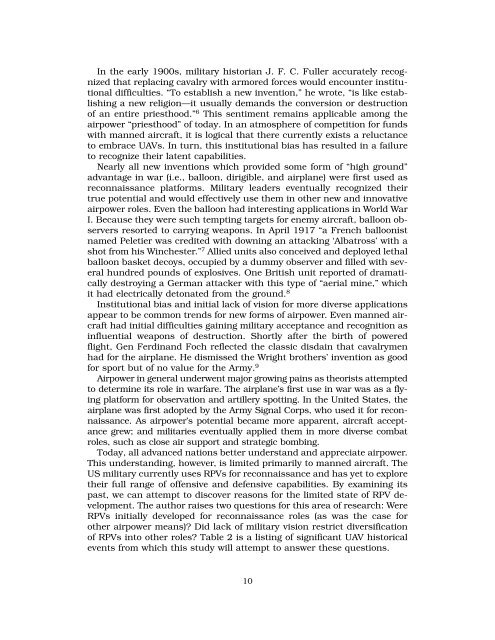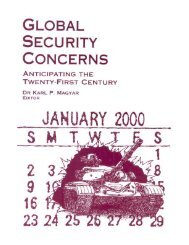Expendable Remotely Piloted Vehicles for Strategic Offensive ...
Expendable Remotely Piloted Vehicles for Strategic Offensive ...
Expendable Remotely Piloted Vehicles for Strategic Offensive ...
Create successful ePaper yourself
Turn your PDF publications into a flip-book with our unique Google optimized e-Paper software.
In the early 1900s, military historian J. F. C. Fuller accurately recognizedthat replacing cavalry with armored <strong>for</strong>ces would encounter institutionaldifficulties. “To establish a new invention,” he wrote, “is like establishinga new religion—it usually demands the conversion or destructionof an entire priesthood.” 6 This sentiment remains applicable among theairpower “priesthood” of today. In an atmosphere of competition <strong>for</strong> fundswith manned aircraft, it is logical that there currently exists a reluctanceto embrace UAVs. In turn, this institutional bias has resulted in a failureto recognize their latent capabilities.Nearly all new inventions which provided some <strong>for</strong>m of “high ground”advantage in war (i.e., balloon, dirigible, and airplane) were first used asreconnaissance plat<strong>for</strong>ms. Military leaders eventually recognized theirtrue potential and would effectively use them in other new and innovativeairpower roles. Even the balloon had interesting applications in World WarI. Because they were such tempting targets <strong>for</strong> enemy aircraft, balloon observersresorted to carrying weapons. In April 1917 “a French balloonistnamed Peletier was credited with downing an attacking ‘Albatross’ with ashot from his Winchester.” 7 Allied units also conceived and deployed lethalballoon basket decoys, occupied by a dummy observer and filled with severalhundred pounds of explosives. One British unit reported of dramaticallydestroying a German attacker with this type of “aerial mine,” whichit had electrically detonated from the ground. 8Institutional bias and initial lack of vision <strong>for</strong> more diverse applicationsappear to be common trends <strong>for</strong> new <strong>for</strong>ms of airpower. Even manned aircrafthad initial difficulties gaining military acceptance and recognition asinfluential weapons of destruction. Shortly after the birth of poweredflight, Gen Ferdinand Foch reflected the classic disdain that cavalrymenhad <strong>for</strong> the airplane. He dismissed the Wright brothers’ invention as good<strong>for</strong> sport but of no value <strong>for</strong> the Army. 9Airpower in general underwent major growing pains as theorists attemptedto determine its role in warfare. The airplane’s first use in war was as a flyingplat<strong>for</strong>m <strong>for</strong> observation and artillery spotting. In the United States, theairplane was first adopted by the Army Signal Corps, who used it <strong>for</strong> reconnaissance.As airpower’s potential became more apparent, aircraft acceptancegrew; and militaries eventually applied them in more diverse combatroles, such as close air support and strategic bombing.Today, all advanced nations better understand and appreciate airpower.This understanding, however, is limited primarily to manned aircraft. TheUS military currently uses RPVs <strong>for</strong> reconnaissance and has yet to exploretheir full range of offensive and defensive capabilities. By examining itspast, we can attempt to discover reasons <strong>for</strong> the limited state of RPV development.The author raises two questions <strong>for</strong> this area of research: WereRPVs initially developed <strong>for</strong> reconnaissance roles (as was the case <strong>for</strong>other airpower means)? Did lack of military vision restrict diversificationof RPVs into other roles? Table 2 is a listing of significant UAV historicalevents from which this study will attempt to answer these questions.10






